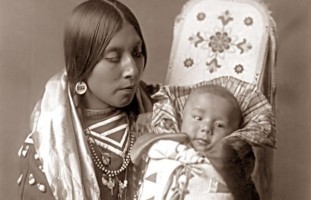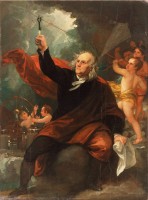Lightning in the Hand
The views expressed are those of the author and do not necessarily reflect the views of ASPA as an organization.
By Jason Bowns
April 7, 2017

Photo Courtesy of Indian Country Today Media Network
A piece of Cherokee wisdom reminds us, “When you were born, you cried and the world rejoiced. Live your life in such a way that when you die the world cries and you rejoice.” We strive to leave the world better than how we found it.
America’s past shapes today’s public policies. We reflect and learn; our country’s lifeblood flows on, as do our own livelihoods. We make sense of what we were so to see where we want to be. Will we chase past glories or pave a new way? Those philosophical debates embody democratic ideals. Disagreement will, hopefully, be a mere waystation on the road to progress.
“It is better to have less thunder in the mouth and more lightning in the hand,” an Apache proverb declares. Beyond the din of our public policy storms and through the rockets’ red glare, what’s written down remains a beacon to guide decisionmakers through otherwise murky waters. Public policy is the lightning in our hands, and we must wield it wisely.
To date, the Federal government has recognized 567 Indian Nations in America. This status confers certain benefits including the right to self-government. State and federal income taxes are not imposed on any income generated on tribal lands. The same goes for sales tax. Native Americans do pay income and sales taxes for transactions off of the tribal reservation.
The Indian Gaming Regulatory Act of 1988, enacted by Congress and signed into law by President Ronald Reagan, established the National Indian Gaming Commission to regulate tribal gaming. The purpose was “to promote tribal economic development, tribal self-sufficiency, and strong tribal government.” Tribes balance economic prosperity with a shared cultural identity.
An early pioneer of tribal gaming is Connecticut’s Mashantucket Pequot Tribal Nation, federally recognized on October 18, 1983. With this newfound sovereignty, the tribe opened bingo operations on its land three years later, ultimately prompting the construction of Foxwoods Resort and Casino in 1992. It remains the largest casino in North America and second largest in the entire world. On March 7, 1994, the Mohegan Tribe also gained federal recognition and constructed Mohegan Sun casino less than ten miles away in Uncasville, Connecticut.
With every application filed for tribal recognition elsewhere, new dilemmas emerge. Policymakers must preserve the integrity of the tribal recognition process and protect the legitimacy of what exactly defines a tribe. One contentious criterion is the group’s proven continuity. How long should a tribe need to document its existence to qualify?
Originally, the standard required proof going back to when the U.S. Constitution was ratified in 1789. A recent effort sought to make that much later. Some testified “the government made it difficult for tribes to exist prior to 1934.” That was the year Congress enacted the Indian Reorganization Act which encouraged tribes to formalize leadership structures and draft governance documents and in exchange they could receive federal subsidies.
The Dawes Act of 1887 had instituted an allotment process which segmented tribal lands, distributing them to individuals. The legislation allowed some reservation lands to go into the hands of those who weren’t even Native Americans, too. So, tribes did have major obstacles until 1934, when public policy started to encourage communities rather than dismantling them.
Ultimately, the new rule adopted in 2015 determined tribes seeking federal recognition must prove continuous existence since 1900. That higher standard remains a barrier for tribes lacking documentation earlier than 1934.
With 567 federally recognized tribes now, we are reminded each has its own past and path forward. Public policy decisions now balance those linked interests. In the quest for economic vitality and viability, tribes should not lose sight of who they are.
 As Benjamin Franklin was in Paris negotiating the treaty which formally ended the Revolutionary War, he also opined about Native Americans. He wrote, “Savages we call them, because their manners differ from ours, which we think the perfection of civility. They think the same of theirs.” It was so prescient of things to come.
As Benjamin Franklin was in Paris negotiating the treaty which formally ended the Revolutionary War, he also opined about Native Americans. He wrote, “Savages we call them, because their manners differ from ours, which we think the perfection of civility. They think the same of theirs.” It was so prescient of things to come.
In noting that difference, Franklin framed how they were so alike. He saw an enduring thread, a question in the cloth of American identity. What place will Native Americans have in it?
These debates remind us public policy is more than words on paper. It remains a potent force affecting the lives of people every day; the ripples endure for generations. Before wielding it, consider what will be the lightning in your hand. What mark will you leave upon this world?
Another Cherokee adage cautions, “Don’t let yesterday use up too much of today.” We must always ensure that our existing systems address current problems, growing up with us.
The evolution of American tribal policy is a perfect example.
Author: Reared in rural Connecticut, Jason Bowns earned a Bachelor of Arts degree from New York University, majoring in Classical Civilization and Hellenic Studies while minoring in Politics and Social Studies Education. He earned his Master of Public Administration degree at John Jay College of Criminal Justice, honing essential skills to detect organizational fraud, waste, and abuse. He’s reachable at [email protected].




 (4 votes, average: 4.00 out of 5)
(4 votes, average: 4.00 out of 5)
 Loading...
Loading...
Lightning in the Hand
The views expressed are those of the author and do not necessarily reflect the views of ASPA as an organization.
By Jason Bowns
April 7, 2017
Photo Courtesy of Indian Country Today Media Network
A piece of Cherokee wisdom reminds us, “When you were born, you cried and the world rejoiced. Live your life in such a way that when you die the world cries and you rejoice.” We strive to leave the world better than how we found it.
America’s past shapes today’s public policies. We reflect and learn; our country’s lifeblood flows on, as do our own livelihoods. We make sense of what we were so to see where we want to be. Will we chase past glories or pave a new way? Those philosophical debates embody democratic ideals. Disagreement will, hopefully, be a mere waystation on the road to progress.
“It is better to have less thunder in the mouth and more lightning in the hand,” an Apache proverb declares. Beyond the din of our public policy storms and through the rockets’ red glare, what’s written down remains a beacon to guide decisionmakers through otherwise murky waters. Public policy is the lightning in our hands, and we must wield it wisely.
To date, the Federal government has recognized 567 Indian Nations in America. This status confers certain benefits including the right to self-government. State and federal income taxes are not imposed on any income generated on tribal lands. The same goes for sales tax. Native Americans do pay income and sales taxes for transactions off of the tribal reservation.
The Indian Gaming Regulatory Act of 1988, enacted by Congress and signed into law by President Ronald Reagan, established the National Indian Gaming Commission to regulate tribal gaming. The purpose was “to promote tribal economic development, tribal self-sufficiency, and strong tribal government.” Tribes balance economic prosperity with a shared cultural identity.
An early pioneer of tribal gaming is Connecticut’s Mashantucket Pequot Tribal Nation, federally recognized on October 18, 1983. With this newfound sovereignty, the tribe opened bingo operations on its land three years later, ultimately prompting the construction of Foxwoods Resort and Casino in 1992. It remains the largest casino in North America and second largest in the entire world. On March 7, 1994, the Mohegan Tribe also gained federal recognition and constructed Mohegan Sun casino less than ten miles away in Uncasville, Connecticut.
With every application filed for tribal recognition elsewhere, new dilemmas emerge. Policymakers must preserve the integrity of the tribal recognition process and protect the legitimacy of what exactly defines a tribe. One contentious criterion is the group’s proven continuity. How long should a tribe need to document its existence to qualify?
Originally, the standard required proof going back to when the U.S. Constitution was ratified in 1789. A recent effort sought to make that much later. Some testified “the government made it difficult for tribes to exist prior to 1934.” That was the year Congress enacted the Indian Reorganization Act which encouraged tribes to formalize leadership structures and draft governance documents and in exchange they could receive federal subsidies.
The Dawes Act of 1887 had instituted an allotment process which segmented tribal lands, distributing them to individuals. The legislation allowed some reservation lands to go into the hands of those who weren’t even Native Americans, too. So, tribes did have major obstacles until 1934, when public policy started to encourage communities rather than dismantling them.
Ultimately, the new rule adopted in 2015 determined tribes seeking federal recognition must prove continuous existence since 1900. That higher standard remains a barrier for tribes lacking documentation earlier than 1934.
With 567 federally recognized tribes now, we are reminded each has its own past and path forward. Public policy decisions now balance those linked interests. In the quest for economic vitality and viability, tribes should not lose sight of who they are.
In noting that difference, Franklin framed how they were so alike. He saw an enduring thread, a question in the cloth of American identity. What place will Native Americans have in it?
These debates remind us public policy is more than words on paper. It remains a potent force affecting the lives of people every day; the ripples endure for generations. Before wielding it, consider what will be the lightning in your hand. What mark will you leave upon this world?
Another Cherokee adage cautions, “Don’t let yesterday use up too much of today.” We must always ensure that our existing systems address current problems, growing up with us.
The evolution of American tribal policy is a perfect example.
Author: Reared in rural Connecticut, Jason Bowns earned a Bachelor of Arts degree from New York University, majoring in Classical Civilization and Hellenic Studies while minoring in Politics and Social Studies Education. He earned his Master of Public Administration degree at John Jay College of Criminal Justice, honing essential skills to detect organizational fraud, waste, and abuse. He’s reachable at [email protected].
Follow Us!